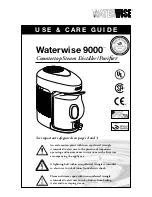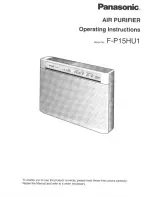
# 48478A006
Page 17
OPERATION
Outdoor unit and indoor blower cycle on demand from the
room thermostat. When the thermostat blower switch is
moved to the ON position, the indoor blower operates
continuously.
Filter Drier
The unit is equipped with a large capacity bi-flow filter
which keeps the system clean and dry. If replacement is
necessary, replace with one of similar design and capac-
ity. The replacement filter drier must be suitable for use
with R410A refrigerant.
Crankcase Heater
If unit is equipped with a crankcase heater, it should
be energized 24 hours before unit start-up to prevent
compressor damage as a result of slugging.
Emergency Heat Function (Room Thermostat)
An emergency heat function is designed into some room
thermostats. This feature is applicable when isolation of
outdoor unit is required or when auxiliary electric heat is
stage by outdoor thermostats. When the room thermostat is
placed in the emergency heat position, the outdoor unit
control circuit is isolated from power and the field-supplied
relays bypass the outdoor thermostats. An amber indicating
light simultaneously comes on to remind the homeowner
that the unit is operating in the emergency heat mode.
Defrost Control Board
Figure 14
S4
Defrost Interval
Timing Pins
Diagnostic LEDs
24V TerminalStrip
Connections
High Pressure Switch
Defrost Thermostat
Low Pressure Switch
Reversing Valve
Compressor Delay Pins
Test Pins
K1 Relay
K2 Relay
FAN
DS1
L
24V
P2
P5
O-OUT
DF
Y1-OUT
HI-PS
U1
U2
DS2
K3 Relay
P6
TST PS DF C
R
O Y1
C5
S87
LO-PS
C2
P1
30
60
90
TEST
W1
C
L
R
Y1
O
Emergency heat is usually used during an outdoor shut-
down, but it should also be used following a power outage if
power has been off for over an hour and the outdoor
temperature is below 50°F. System should be left in the
emergency heat mode at least 6 hours to allow the crank-
case heater sufficient time to prevent compressor slugging.
Defrost System
The defrost system includes two components: the defrost
thermostat and the defrost control.
Defrost Thermostat
The defrost thermostat is located on the liquid line be-
tween the check/expansion valve and the distributor.
When the defrost thermostat senses 42°F or cooler, the
thermostat contacts close and send a signal to the defrost
control board to start the defrost timing. It also terminates
defrost when the liquid line warms up to 70°F.
Defrost Control
The defrost control board includes the combined functions
of time/temperature defrost control, defrost relay, diagnos-
tic LEDs and terminal strip for field wiring connections
(see Figure 14).
The control provides automatic switching from normal
heating operation to defrost mode and back. During the
compressor cycle (call for defrost), the control accumu-
lates compressor run time at 30, 60, 90 minute field-











































